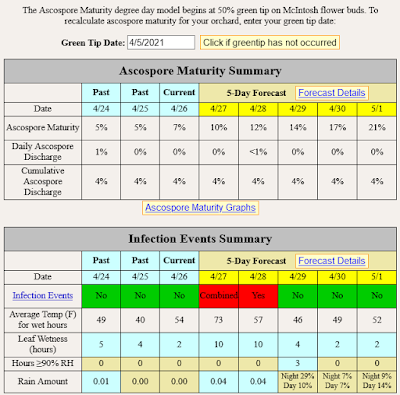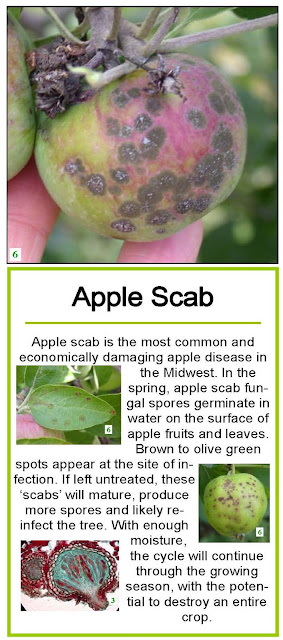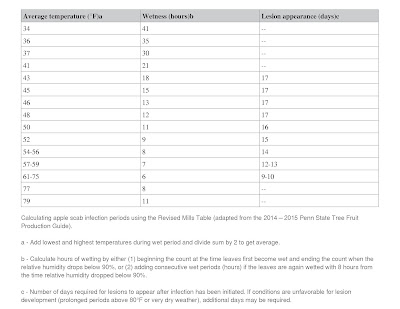Based on our NEWA (Network for Environment and Weather Applications) Apple Scab Model, we have had multiple scab infection events beginning March 23 with spore maturity being very low (see chart below). But, with the first infection period, even though leaf tissues had not formed yet, the scab season has officially begun! With no leaf tissue showing prior to green tip, any previous infection period would have no immediate effect on the leaf tissue, but we now know that there are spores out there. Since we had our copper spray put on right at green tip the evening of April 7 and 8, we were protected from the infection once the spores began to mature. With spore maturity and discharge being very low, the risk is also very low, but we still need to be protected because any high temperature day can cause the spores to mature very quickly.
Ascospores mature as spring progresses with a few ascospores usually
maturing by bud break (green tip). The proportion of ascospores maturing
progresses slowly until about the tight cluster stage of blossom
development. From tight cluster through bloom the percentage of mature
ascospores rapidly increases with most ascospores matured by the end of
bloom. In the chart below, we cab see that the ascospore maturity level is still quite low.
Unusual weather conditions may contribute to significant ascospore discharges earlier than or later than the model predicts, and for that reason, we want to be sure we have a protective cover spray on the trees..
Mature ascospores begin to discharge into the air within 30 minutes during periods of rain. When rainfall begins at night, discharge may be delayed until daybreak. Ascospore discharge usually peaks from pink through bloom, and nearly all ascospores have been discharged within 1 or 2 weeks after petal fall.
Copper has been shown to be a protectant against scab on the tissue that has been covered, but not on any new tissue that would have grown since that copper spray was put on. If no copper spray has been put on your trees as of today, and you have not put any other protectant on like Captan or Mancozeb, you still have time to get an eradicant fungicide put on your trees in the form of Immunox, which has a 72 to 96 hour reach back ability. That means that you have up to 72 to 96 hours to get a spray on which will still be effective against any scab infection event 72 to 96 hours previous. Immunox is a xylum mobile fungicide which means when applied to leaves it will move throughout the leaves it was deposited on but will not move out of that leaf (McGrath, M.T. 2004. What are Fungicides. The Plant Health Instructor. DOI: 10.1094/PHI-I-2004-0825-01. Updated 2016.)
Mature ascospores begin to discharge into the air within 30 minutes during periods of rain. When rainfall begins at night, discharge may be delayed until daybreak. Ascospore discharge usually peaks from pink through bloom, and nearly all ascospores have been discharged within 1 or 2 weeks after petal fall.
Copper has been shown to be a protectant against scab on the tissue that has been covered, but not on any new tissue that would have grown since that copper spray was put on. If no copper spray has been put on your trees as of today, and you have not put any other protectant on like Captan or Mancozeb, you still have time to get an eradicant fungicide put on your trees in the form of Immunox, which has a 72 to 96 hour reach back ability. That means that you have up to 72 to 96 hours to get a spray on which will still be effective against any scab infection event 72 to 96 hours previous. Immunox is a xylum mobile fungicide which means when applied to leaves it will move throughout the leaves it was deposited on but will not move out of that leaf (McGrath, M.T. 2004. What are Fungicides. The Plant Health Instructor. DOI: 10.1094/PHI-I-2004-0825-01. Updated 2016.)

 For the home grower who may not have a weather station or scab model to help predict the apple scab infection periods, monitoring for apple scab can be quite complicated. But there is an alternative. Unless wetness periods are being monitored as outlined in the section above, you can simply apply protective or eradicant fungicides at regular intervals beginning with green tip. Spraying should be done every 7 to 10 days, depending on the number of rain events between sprays. If there are no rain events between sprays, a single protectant spray will last at least 10 days but not more than 14 days, based on the product's label directions. You will need to make sure that your trees and fruit are protected prior to any rain event if you are going to use only a protectant. A good protectant is Captan or Mancozeb. But, a protectant can lose its effectivness after 2" of rain, so you also want to keep an eradicant on hand like a myclobutanil, which is available as Spectracide Immunox, which I mention above.
For the home grower who may not have a weather station or scab model to help predict the apple scab infection periods, monitoring for apple scab can be quite complicated. But there is an alternative. Unless wetness periods are being monitored as outlined in the section above, you can simply apply protective or eradicant fungicides at regular intervals beginning with green tip. Spraying should be done every 7 to 10 days, depending on the number of rain events between sprays. If there are no rain events between sprays, a single protectant spray will last at least 10 days but not more than 14 days, based on the product's label directions. You will need to make sure that your trees and fruit are protected prior to any rain event if you are going to use only a protectant. A good protectant is Captan or Mancozeb. But, a protectant can lose its effectivness after 2" of rain, so you also want to keep an eradicant on hand like a myclobutanil, which is available as Spectracide Immunox, which I mention above. A protectant like Captan has to be applied prior to a rain event. If no protection is available during the wetting event, then only an eradicant like Immunox can be applied that has a reach back of 72 to 96 hours as I have stated above. That means that it can still have an effect on the scab pathogen for up to 96 hours after a wetting event, although it is a good practice to use the shorter 72 hours.. A good option is to actually use both a protectant and an erdicant at the same time, like Captan mixed with Immunox, which will give you both protection and eradicant action after a wetting event. Be sure to monitor wetness periods throughout the spring to insure that trees are always adequately protected.
But, regardless of
the type of mobility that a fungicide possesses, no fungicide is
effective after the development of visible disease symptoms. For that
reason, timely fungicide application before establishment of the disease
is important for optimal disease management.
_____________________________________________________________
This publication contains pesticide recommendations that are subject to change at any time. These recommendations are provided only as a guide. It is always the pesticide applicator's responsibility, by law, to read and follow all current label directions for the specific pesticide being used. Due to constantly changing labels and product registration, some of the recommendations given in this writing may no longer be legal by the time you read them. If any information in these recommendations disagrees with the label, the recommendation must be disregarded. No endorsement is intended for products mentioned, nor is criticism meant for products not mentioned. The author assumes no liability resulting from the use of these recommendations.









